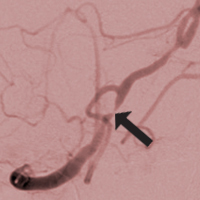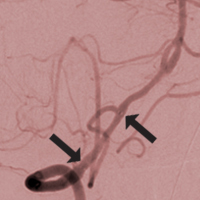Artery-opening brain stents designed to reduce high risk of repeat strokes instead significantly increased strokes and deaths, results of a multi-center clinical trial show.
The research is reported online Sept. 7, 2011, in The New England Journal of Medicine.

Colin Derdeyn
Arrow points to a narrow brain artery.
In the first month after treatment, patients with the stents experienced more than twice the rate of strokes and deaths compared to patients without them, prompting the National Institute of Neurological Disorders and Stroke to halt trial enrollment in April.
The National Institutes of Health issued a clinical alert at that time to inform doctors and the public of the study’s results. The alert will likely shift the preferred treatment for these patients to medications and lifestyle changes that reduce clotting and lower blood pressure and cholesterol. The study provides a more detailed report of what happened during the trial, which was conducted at 50 medical centers across the nation.

Colin Derdeyn
Arrows point to each end of a stent, inserted to prevent stroke recurrence. But now a multicenter study has found evidence that the stents increase stroke risk.
The 450 patients in the study had recently had strokes or temporary stroke-like symptoms associated with significant narrowing of a major brain artery. This narrowing reduces blood flow in the brain and puts patients at high risk of additional strokes.
All patients received blood-thinning drugs and aggressive treatments to lower blood pressure and cholesterol, two key risk factors for stroke. Half the patients were randomly selected to receive the stents.
The researchers found that nearly 15 percent of patients treated with stents had a second stroke or died in the first 30 days after treatment, while less than 6 percent in the control group had another stroke or died in the same time period.
During a nearly one-year follow-up period, 20.5 percent of patients in the stent group and 11.5 percent of patients in the control group had a stroke or died.
“The complications on the stent side of the trial were higher than we expected,” says co-principal investigator Colin P. Derdeyn, MD, professor of radiology at Washington University School of Medicine in St. Louis. “Further research may identify specific groups of patients who may benefit from these stents, but for now we seem to be able to save more lives by aggressively working to lower blood pressure and cholesterol.”
The researchers are now trying to determine why patients with the stents experienced high rates of strokes and death. Among the possibilities are blood clots forming on the stents or breaking loose from blood vessel walls. Damage to blood vessels during installation of the stents may also have increased risk.
Stroke is the fourth leading cause of death in the United States. Stenosis, a blockage or narrowing of brain arteries caused by the buildup of plaques and clots, accounts for more than 50,000 of the 795,000 strokes that occur annually nationwide. Stenosis is particularly common in African-Americans, Hispanics, Asian-Americans and people with diabetes.
The only FDA-approved device dedicated to blocked arteries in the brain is the Gateway-Wingspan system. This technology allows physicians to open a blocked cranial artery by inserting a balloon into the artery and inflating it. Next, physicians insert a stent to keep the artery open.
Derdeyn and lead author Mark Chimowitz, MBChB, of the department of neurosciences at the Medical University of South Carolina in Charleston, wanted to test the risks and benefits of Gateway-Wingspan in a randomized clinical trial. They designed the Stenting vs. Aggressive Medical Management for Preventing Recurrent Stroke in Intracranial Stenosis
“An earlier study found that high blood pressure and cholesterol levels in this group of patients was strongly associated with increased stroke risk,” Derdeyn says. “We developed ‘aggressive medical management’ protocols that asked treating physicians to work hard to bring patient blood pressure and cholesterol into safe ranges. We also regularly monitored patients to see if these goals were being met.”
The trial began in 2008.
“We only accepted patients whose stenoses blocked 70 percent or more of an artery, so this was a very high-risk group,” says Derdeyn, who is director of the Stroke and Cerebrovascular Center at Barnes-Jewish Hospital and the School of Medicine. “While we were selective in that regard, we did not investigate the nature of the blockages — for example, how much of the blockage was plaque only and how much of it was blood clot on a plaque. These patients may have different risk of stroke with stenting.”
That kind of information, potentially available through the latest scanning techniques, could help Derdeyn and other doctors who care for these patients to customize treatment plans.
The researchers will continue to follow the patients who have already been treated for two more years.
Chimowitz MI, Lynn, MJ, Derdeyn CP, Turan TN, Fiorella D, Lane, BF, Janis, S, Lutsep HL, Barnwell SL, Waters MF, Hoh BL, Hourihane JM, Levy EI, Alexandrov AV, Harrigan MR, Chiu D, Klucznik RP, Clark JM, McDougall CG, Johnson, MD, Pride, GL, Torbey MT, Zaidat OO, Rumboldt Z, Cloft HJ, for the Stenting and Aggressive Medical Management for Preventing Recurrent Stroke in Intracranial Stenosis Trial Investigators, Stenting versus aggressive medical therapy for intracranial artery stenosis, The New England Journal of Medicine, published online Sept. 7, 2011.
Funding from the National Institute of Neurological Disorders and Stroke supported this research.
Washington University School of Medicine’s 2,100 employed and volunteer faculty physicians also are the medical staff of Barnes-Jewish and St. Louis Children’s hospitals. The School of Medicine is one of the leading medical research, teaching and patient care institutions in the nation, currently ranked fourth in the nation by U.S. News & World Report. Through its affiliations with Barnes-Jewish and St. Louis Children’s hospitals, the School of Medicine is linked to BJC HealthCare.